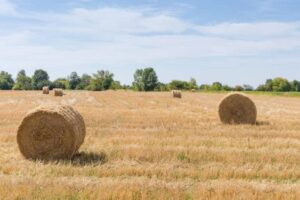Baling twine is an essential tool for farmers to use when packing hay. It has high tensile strength and the force a single unknotted cord can hold before breaking.
It is also easy to work with and has good knot strength. In addition, it is highly resistant to bad weather conditions.
It is made from natural fibres.
 The baler twine used to bind hay or straw into round bales is often made from natural fibres, such as sisal. However, many types of artificial cords are also available in balers. These are usually manufactured from synthetic materials like polypropylene or nylon. These twines are typically non-biodegradable and linger in the environment for years, which poses a serious threat to animals and the soil. Fortunately, there are some ways to reduce the environmental impact of baler twine.
The baler twine used to bind hay or straw into round bales is often made from natural fibres, such as sisal. However, many types of artificial cords are also available in balers. These are usually manufactured from synthetic materials like polypropylene or nylon. These twines are typically non-biodegradable and linger in the environment for years, which poses a serious threat to animals and the soil. Fortunately, there are some ways to reduce the environmental impact of baler twine.
One option is to recycle the twine after use. Another option is to try using alternative tying methods that require less yarn. For example, string or netting can tie up tomato plants instead of twine, reducing waste and environmental harm. Some farms also use recycled or biodegradable https://silagewrap.com.au baling twine to minimise its environmental impact.
Although commonly used in agriculture, baling twine can cause health problems for livestock and humans if improperly handled. Livestock may accidentally ingest the cord while eating, leading to digestive issues or even death. In addition, the sharp edges and frayed strands of the twine can create physical hazards for humans and animals. The string can also entangle with machinery or pose a trip hazard.
Some farmers are exploring sustainable alternatives to baling twine, such as jute or hemp. These alternatives are sustainable and help reduce the environmental impact of synthetic strings, which can take hundreds of years to decompose. Additionally, they release low levels of volatile organic compounds (VOCs) into the air.
Traditionally, baler twine was made from natural fibres, but today’s technology has allowed manufacturers to produce the same tying power from synthetic materials. Regardless of the type of twine used, getting the right style for your baler is essential. You should choose a string that is strong and consistent. This will allow the baler to work efficiently and prevent it from breaking or tying itself in knots. Coastal carries a wide selection of synthetic and sisal baler twine to suit your needs. You can even find a variety of colours to identify different paddocks, cuttings, fields, or persons doing the baling.
It is easy to work with
https://silagewrap.com.au baling twine is easy to work with and can be purchased in various lengths and colours. It is also rot-resistant and resists mildew. It is also easier to knot than other ties. Choosing the proper twine for your specific needs is essential, as each type has a different purpose and will suit various machinery. Selecting the correct string can ensure that your balers run smoothly and efficiently.
Traditional sisal baling twine is made from individual strands of natural plant materials twisted together. It’s biodegradable and is used for tying hay bales. It’s also often found in bird nests, providing a good fibre source for chicks. On the other hand, synthetic baling twine is typically constructed from polypropylene and nylon. This synthetic twine doesn’t decompose quickly and may linger in the environment for years, polluting soil and water.
Farmers are increasingly switching from conventional twine to sustainable alternatives, such as sisal or hemp baler twine, which offer an environmentally friendly solution. Alternatively, many consider using hay or straw without binding it into bales altogether. This could reduce the need for tying twine, and it might also reduce waste.
In addition to being a significant environmental hazard, synthetic twine can create fire hazards and entangle machinery and animals. It can also contaminate the soil, leading to environmental pollution and harm to wildlife. It’s best to dispose of baling twine properly by placing it inside a trash can or recycling bin and packing it tightly before throwing it away.
Keeping the areas around lakes, rivers, and streams clean of twine helps Osprey and all other fish, wildlife, and humans who enjoy these habitats. Osprey begins their migration from wintering grounds in early spring and continues building and adding material to their nests through July. It is essential to pick up and dispose of all baling twine when it’s picked up, or it can entangle birds and damage equipment.
Horse lovers use https://silagewrap.com.au baling twine to repair everything from broken reins and bridles to stirrup leathers. It’s also great for tying up water bottles or fly spray and looping blankets or ribbons over barred stall doors at horse shows. A piece of twine can also make a handy temporary toilet paper or paper towel holder in a barn bathroom.
It is strong
Twine is a versatile material that can be used in many ways. It is also a vital part of making bales. This is because it binds the straw, hay, and other materials used for feed. It also provides a way to keep animals in place. However, it can be dangerous if not correctly used. This is why it is essential to use high-quality twine.